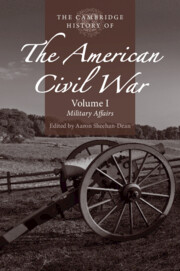Book contents
- The Cambridge History of the American Civil War
- The Cambridge History of the American Civil War
- The Cambridge History of the American Civil War
- Copyright page
- Contents
- Maps
- Contributors to Volume I
- Acknowledgments
- Note on the Text
- 1 Introduction: The Cambridge History of the American Civil War
- Part I Major Battles and Campaigns
- 2 The Battles of Virginia, 1861
- 3 The Battles of Tennessee, 1862
- 4 The Battles of the Trans-Mississippi, 1861–1863
- 5 The Peninsula Campaign
- 6 The Shenandoah Valley Campaigns of 1862 and 1864
- 7 The Second Bull Run Campaign
- 8 The Antietam Campaign
- 9 The Western Theater, 1862–1863
- 10 The Battle of Fredericksburg
- 11 The Chancellorsville Campaign
- 12 The Gettysburg Campaign
- 13 The Vicksburg Campaign
- 14 The Battles of Tennessee, 1863
- 15 The Overland Campaign
- 16 The Georgia Campaign
- 17 The Carolinas Campaign
- 18 The Tennessee Campaign, 1864
- 19 The Petersburg and Appomattox Campaigns
- Part II Places
- Index
- References
9 - The Western Theater, 1862–1863
from Part I - Major Battles and Campaigns
Published online by Cambridge University Press: 11 October 2019
- The Cambridge History of the American Civil War
- The Cambridge History of the American Civil War
- The Cambridge History of the American Civil War
- Copyright page
- Contents
- Maps
- Contributors to Volume I
- Acknowledgments
- Note on the Text
- 1 Introduction: The Cambridge History of the American Civil War
- Part I Major Battles and Campaigns
- 2 The Battles of Virginia, 1861
- 3 The Battles of Tennessee, 1862
- 4 The Battles of the Trans-Mississippi, 1861–1863
- 5 The Peninsula Campaign
- 6 The Shenandoah Valley Campaigns of 1862 and 1864
- 7 The Second Bull Run Campaign
- 8 The Antietam Campaign
- 9 The Western Theater, 1862–1863
- 10 The Battle of Fredericksburg
- 11 The Chancellorsville Campaign
- 12 The Gettysburg Campaign
- 13 The Vicksburg Campaign
- 14 The Battles of Tennessee, 1863
- 15 The Overland Campaign
- 16 The Georgia Campaign
- 17 The Carolinas Campaign
- 18 The Tennessee Campaign, 1864
- 19 The Petersburg and Appomattox Campaigns
- Part II Places
- Index
- References
Summary
Ulysses S. Grant’s successful campaign against Forts Henry and Donelson in February 1862 left the western Confederacy reeling. The capture of the Tennessee and Cumberland river forts placed nearly a third of available Confederate troop strength in the theater into Federal custody. Flanked by Grant and facing Don Carlos Buell’s approaching Army of the Ohio as well, Confederate department commander Albert Sidney Johnston led a ragged, dismal, rain and sleet soaked retreat out of southern Kentucky. Plagued by desertions and stragglers, his army stumbled across Tennessee until it reached northern Mississippi. Nashville, one of the Confederacy’s most industrialized cities, fell without a fight in Johnston’s wake before the month ended, and soon with it most of Middle Tennessee’s rich farmlands. Simultaneously, John Pope’s Army of the Mississippi and Andrew Foote’s fleet of Union gunboats pursued Confederates fleeing their Mississippi River “Gibraltar” at Columbus, Kentucky. They drove down the flooded river valley until encountering the Confederate bastion at Island No. 10 opposite New Madrid, Missouri. Farther west across the river, Federal troops under Samuel Curtis already were in the act of shoving Sterling Price’s secessionist Missourians out of southwestern Missouri into Arkansas during a brutal winter campaign. Reuniting the separated Confederate forces including Price’s that had won a victory at Wilson’s Creek the previous summer, new Confederate commander Earl Van Dorn launched an ill-fated attack at Pea Ridge, Arkansas, that left his defeated army staggering southward in the cold. Not surprisingly, given the collapse of the Confederacy’s western line of defenses and its apparent implosion, many Federal soldiers gleefully anticipated a prompt end to the war after an additional season of mopping up.
- Type
- Chapter
- Information
- The Cambridge History of the American Civil War , pp. 165 - 182Publisher: Cambridge University PressPrint publication year: 2019



